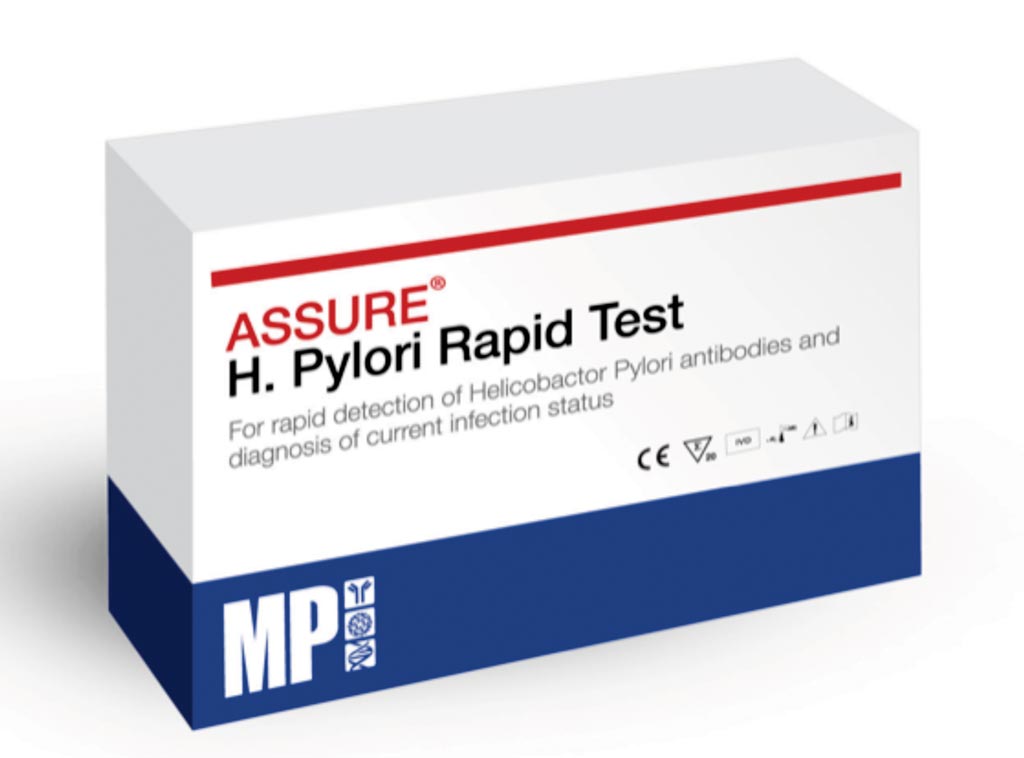Serum Pepsinogen Validated for Atrophic Gastritis Diagnosis
By LabMedica International staff writers
Posted on 01 Aug 2017
Atrophic gastritis (AG) and intestinal metaplasia (IM) are well-recognized as high-risk conditions for developing gastric cancer (GC), and both have been identified as the precancerous lesions, but the clinical symptoms of AG are not specific.Posted on 01 Aug 2017
The early detection of precancerous lesions of GC in general population and following up with the condition are important considerations for reducing mortality, increasing survival rates, and improving quality of life. The measurement of pepsinogen (PG) as a screening test for chronic atrophic gastritis (AG) in health check-up populations has been suggested.

Image: The Assure H. Pylori Rapid Test is an immunochromatographic test for diagnosing infection from H. pylori in patients with gastric disorders (Photo courtesy of MP Biomedicals).
Physicians at the Second Affiliated Hospital of Zhejiang University (Hangzhou, China) enrolled subjects, who received consecutive regular health check-up from January 2014 to June 2015. The patients included in this study ranged from 20 to 70 years in age. All the participants underwent gastroendoscopy and pathology tests, serum PG test, 13C–urea breath test or Helicobacter pylori (Hp) serological current infection marker rapid test in one day.
Serum PG levels were assayed by chemiluminescent microparticle immunoassay method using Abbott ARCHITECT Pepsinogen I and II Reagent Kit. Each subject was also examined with 13C–urea breath test or Hp serological current infection marker rapid test. Hp infection was determined based on the results of 13C–urea breath test or H. pylori serological rapid current infection marker test, combined with the pathological screening.
The scientists found the total Hp infection rate was 40% and based on pathology, the 996 participants were divided into three groups: non-atrophic (NAG), mild-moderate atrophic (MAG), and severe atrophic (SAG). Compared with NAG and MAG groups, the Pepsinogen I (PGI)/ Pepsinogen II (PGII) ratio (PGR) decreased significantly in SAG group. PGI and PGII levels were significantly elevated in Hp-positive group, while the PGR was markedly decreased. When MAG and SAG groups were combined and compared with NAG group, the best cutoff value for atrophy diagnosis was PGI ≤50.3 ng/mL; the cutoff value in Hp-negative group was absolutely higher than in Hp-positive group. When NAG and MAG groups were combined and compared with the SAG group, the best cutoff value for diagnosis of severe atrophy was at PGR ≤4.28. The cutoff values in Hp-negative and Hp-positive groups were calculated at PGR ≤6.28 and ≤4.28, respectively.
The authors concluded that serum pepsinogens are a cost effective screening method in the identification of patients with AG, especially severe AG, which are precancerous lesions of GC. The use of different cutoff values of PG for Hp-negative and Hp-positive groups may offer greater efficacy in the diagnosis of AG. The study was published on July 20, 2017, in the journal BMC Gastroenterology.
Related Links:
Second Affiliated Hospital of Zhejiang University













